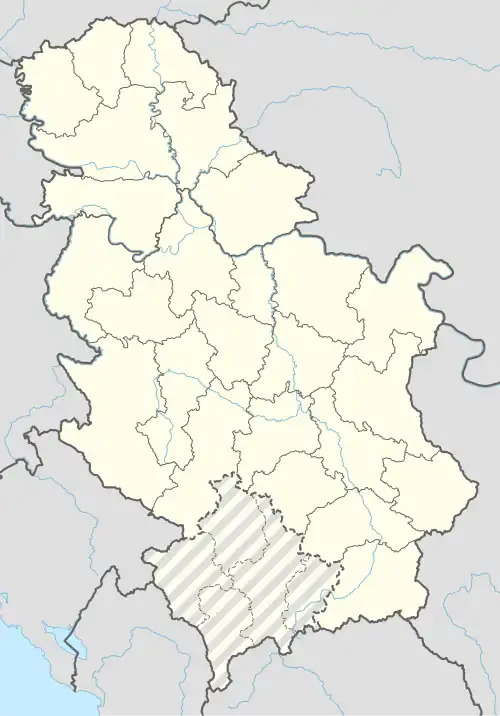Đake
Đake
Ђаке (Serbian) | |
|---|---|
Village | |
 Đake | |
| Coordinates: 43°02′00″N 21°25′18″E / 43.03333°N 21.42167°E | |
| Country | |
| District | Toplica District |
| Municipality | Kuršumlija |
| Population (2002) | |
• Total | 83 |
| Time zone | UTC+1 (CET) |
| • Summer (DST) | UTC+2 (CEST) |
Đake (Serbian Cyrillic: Ђаке) is a village in the municipality of Kuršumlija, Serbia. According to the 2002 census, the village had a population of 83 people.[1]
History
Đake was inhabited by Albanians before the Expulsion of the Albanians took place in 1877–1878.[2] All Albanians left the Kuršumlija region by force of the Serbian army and fled to modern-day Kosovo, which was back then the Vilayet of Kosovo of the Ottoman Empire. These Albanians became known as Muxhahirs ("Muslim refugees" in Albanian)[3] and were demographically Albanians of the Gheg dialect and Muslims.
The name of the village is considered to come from the Albanian word Gjak and appears there since at least the 15th century. Next to the village is Mali Gjake (The mountain of Gjake).[4]
Some families in Kosovo kept their surname (Xhaka) as the village they were from.
References
- ^ Popis stanovništva, domaćinstava i Stanova 2002. Knjiga 1: Nacionalna ili etnička pripadnost po naseljima. Republika Srbija, Republički zavod za statistiku Beograd 2003. ISBN 86-84433-00-9
- ^ "The Expulsion of Albanians from the Sanjak of Nish" (PDF). State Agency of Kosovo Archives.
- ^ Malcolm, Noel (1998). Kosovo: A short history. Macmillan. p. 229. ISBN 9780810874831. "All these new arrivals were known as muhaxhirs (Trk.: muhacir Srb.: muhadžir), a general word for Muslim refugees. The total number of those who settled in Kosovo is not known with certainty: estimates ranged from 20,000 to 50,000 for Eastern Kosovo, while the governor of the vilayet gave a total of 65,000 in 1881, some of whom were in the sancaks of Skopje and Novi Pazar. At a rough estimate, 50,000 would seem a reasonable figure for those muhaxhirs of 1877–8 who settled in the territory of Kosovo itself."
- ^ Uka, Sabit (2004). Jeta dhe veprimtaria e shqiptarëve të Sanxhakut të Nishit deri më 1912 [Life and activity of Albanians in the Sanjak of Nish up to 1912]. Verana. pp. 244–245. ISBN 9789951864527. Eshtë, po ashtu, me peshë historike një shënim i M. Gj Miliçeviqit, i cili bën fjalë përkitazi me Ivan Begun. Ivan Begu, sipas tij ishte pjesëmarrës në Luftën e Kosovës 1389. Në mbështetje të vendbanimit të tij, Ivan Kullës, fshati emërtohet Ivan Kulla (Kulla e Ivanit), që gjendet në mes të Kurshumlisë dhe Prokuplës. M. Gj. Miliçeviqi thotë: "Shqiptarët e ruajten fshatin Ivan Kullë (1877–1878) dhe nuk lejuan që të shkatërrohet ajo". Ata, shqiptaret e Ivan Kullës (1877–1878) i thanë M. Gj. Miliçeviqit se janë aty që nga para Luftës se Kosovës (1389). [12] Dhe treguan që trupat e arrave, që ndodhen aty, ata i pat mbjellë Ivan beu. Atypari, në malin Gjakë, nodhet kështjella që i shërbeu Ivanit (Gjonit) dhe shqiptarëve për t'u mbrojtur. Aty ka pasur gjurma jo vetëm nga shekulli XIII dhe XIV, por edhe të shekullit XV ku vërehen gjurmat mjaft të shumta toponimike si fshati Arbanashka, lumi Arbanashka, mali Arbanashka, fshati Gjakë, mali Gjakë e tjerë. [13] Në shekullin XVI përmendet lagja shqiptare Pllanë jo larg Prokuplës. [14] Ne këtë shekull përmenden edhe shqiptarët katolike në qytetin Prokuplë, në Nish, në Prishtinë dhe në Bulgari.[15].... [12] M. Đj. Miličević. Kralevina Srbije, Novi Krajevi. Beograd, 1884: 354. "Kur flet mbi fshatin Ivankullë cekë se banorët shqiptarë ndodheshin aty prej Betejës së Kosovës 1389. Banorët e Ivankullës në krye me Ivan Begun jetojnë aty prej shek. XIV dhe janë me origjinë shqiptare. Shqiptarët u takojnë të tri konfesioneve, por shumica e tyre i takojnë atij musliman, mandej ortodoks dhe një pakicë i përket konfesionit katolik."